Improvement in Abrasive Wear Resistance of Metal Matrix Composites Used for Diamond–Impregnated Tools by Heat Treatment
Abstract
:1. Introduction
2. Experimental Procedures
2.1. Materials
- Milling a mixture of 49.7% Astaloy CrM, 49.7% Distaloy DC1 and 0.6% graphite in a planetary mill for 2 h, at 200 rpm (≈0.7 of the critical speed), in air. The milling took place in a WC-lined vial filled to 50% of its volume with 12 mm WC balls and the ball-to-powder weight ratio of 10:1. Thus obtained powder is henceforth referred to as DCM.
- Mixing the base Fe-Mn-Cu-Sn-C powder with 10, 30 and 50% of DCM for 2 h in a Turbula-type mixer.
- Ball milling of the mixtures in a planetary mill using conditions described above.
2.2. Characterization
3. Results and Discussion
3.1. Powder Characterization
3.2. Composite Characterization
3.2.1. Density and Hardness Measurements
3.2.2. Flexural Strength
3.2.3. Wear Testing of Non-Diamond Specimens
3.2.4. Microscopic Observation
3.2.5. Raman Spectroscopy
3.2.6. X-ray Diffraction
3.2.7. Wear Testing of Diamond-Impregnated Specimens
4. Conclusions
Author Contributions
Funding
Institutional Review Board Statement
Informed Consent Statement
Data Availability Statement
Acknowledgments
Conflicts of Interest
References
- Żak-Szwed, M.; Konstanty, J.; Zielińska-Lipiec, A. Iron-base PM matrix alloys for diamond impregnated tools. Int. J. Powder Metall. 2009, 45, 2009. [Google Scholar]
- Konstanty, J.; Stephenson, T.F.; Tyrała, D. Novel Fe-Ni-Cu-Sn matrix materials for the manufacture of diamond-impregnated tools. Diam. Tool. J. 2011, 3, 26–29. [Google Scholar]
- Romański, A.; Tokarski, T.; Tyrała, D. Sintered Fe-Ni-Cu-Sn-C Alloys Made of Ball-Milled Powders. Arch. Metall. Mater. 2014, 59, 947–950. [Google Scholar]
- Ye, X.; Guo, S.; Yang, L.; Gao, J.; Peng, J.; Hu, T.; Wang, L.; Hou, M.; Luo, Q. New utilization approach of microwave thermal energy: Preparation of metallic matrix diamond tool bit by microwave hot-press sintering. J. Alloys Compd. 2018, 748, 645–652. [Google Scholar]
- Li, M.; Sun, Y.; Meng, Q.; Wu, H.; Gao, K.; Liu, B. Fabrication of Fe-Based Diamond Composites by Pressureless Infiltration. Materials 2016, 9, 1006. [Google Scholar] [CrossRef]
- Zaitsev, A.A.; Sidorenko, D.A.; Levashov, E.A.; Kurbatkina, V.V.; Rupasov, S.I.; Andreev, V.A.; Sevast’yanov, P.V. Development and Application of the Cu-Ni-Fe-Sn Based Dispersion Hardened Bond for Cutting Tools of Superhard Materials. J. Superhard Mater. 2012, 34, 270–280. [Google Scholar]
- Chen, F.; Yan, Z.; Liu, Z.; Long, Y.; Fu, N.; Zhang, F.; Liu, B.; Liu, Y. Preparation and properties of Al2O3-reinforced Cu-Ni-Sn metallic matrix for applications in diamond-cutting tools. Diam. Relat. Mater. 2020, 109, 108025. [Google Scholar]
- De Oliveira, L.J.; Bobrovnitchii, G.S.; Filgueira, M. Processing and characterization of impregnated diamond cutting tools using a ferrous metal matrix. Int. J. Refract. Hard Mater. 2007, 25, 328–335. [Google Scholar]
- Tyrała, D.; Romański, A.; Konstanty, J. The Effects of Powder Composition on Microstructure and Properties of Hot-Pressed Matrix Materials for Sintered Diamond Tools. J. Mater. Eng. Perform. 2020, 29, 1467–1472. [Google Scholar]
- Loginov, P.A.; Sidorenko, D.A.; Bychkova, M.Y.; Zaitsev, A.A. Performance of diamond drill bits with hybrid nanoreinforced Fe-Ni-Mo binder. Int. J. Adv. Manuf. Technol. 2019, 102, 2041–2047. [Google Scholar]
- Sun, L.; Pan, J.; Lin, C. A new approach to improve the performance of diamond sawblades. Mater. Lett. 2002, 57, 1010–1014. [Google Scholar] [CrossRef]
- Yamaguchi, K.; Ohara, T.; Ueda, S.; Takeda, Y. Copper enrichment of iron-base alloy scraps by phase separation in liquid Fe-Cu-P and Fe-Cu-P-C systems. Mater. Trans. 2006, 47, 1864–1868. [Google Scholar] [CrossRef]
- Crozet, C.; Verdier, M.; Lay, S.; Antoni-Zdziobek, A. Effect of cooling rates on γ → α transformation and metastable states in Fe-Cu alloys with addition of Ni. Met. Mater. Int. 2018, 24, 681–692. [Google Scholar] [CrossRef]
- Liu, B.; Wang, J.; Liu, Y.; Fang, Q.; Wu, Y.; Chen, S.; Liu, C.T. Microstructure and mechanical properties of equimolar FeCoCrNi high entropy alloy prepared via powder extrusion. Intermetallics 2016, 75, 25–30. [Google Scholar] [CrossRef]
- Shi, H.; Duan, L.; Tan, S.; Fang, X. Influence of pre-alloying on Fe-Cu based metal matrix composite. J. Alloys Compd. 2021, 868, 159134. [Google Scholar] [CrossRef]
- Hu, H.X.; Chen, W.; Deng, C. Effect of Fe prealloyed powder and the sintering process on the matrix properties of impregnated diamond bits. J. Mater. Res. Technol. 2021, 12, 150–158. [Google Scholar] [CrossRef]
- Luno-Bilbao, C.; Iturriz, I. Improvement in hardness and wear behaviour of sintered prealloyed bonds for diamond impreganted tools by heat treatments. In Proceedings of the V Congreso Nacional de Pulvimetalurgia, Girona, Spain, 1–3 July 2015. [Google Scholar]
- Konstanty, J.; Romański, A.; Bączek, E.; Tyrała, D. New Wear Resistant Iron-Base Matrix Materials for the Fabrication of Sintered Diamond Tools. Arch. Metall. Mater. 2015, 60, 633–637. [Google Scholar] [CrossRef]
- Bączek, E.; Konstanty, J.; Romański, A.; Podsiadło, M.; Cyboroń, J. Processing and Characterization of Fe-Mn-Cu-Sn-C Alloys Prepared by Ball Milling and Spark Plasma Sintering. J. Mater. Eng. Perform. 2018, 27, 1475–1483. [Google Scholar] [CrossRef]
- Konstanty, J.S.; Bączek, E.; Romański, A.; Tyrała, D. Wear-resistant iron-based Mn-Cu-Sn matrix for sintered diamond tools. Powder Metall. 2018, 61, 43–49. [Google Scholar] [CrossRef]
- Cygan-Bączek, E.; Wyżga, P.; Cygan, S.; Bała, P.; Romański, A. Improvement in hardness and Wear behaviour of iron-based Mn–Cu–Sn matrix for sintered diamond tools by dispersion strengthening. Materials 2021, 14, 1774. [Google Scholar] [CrossRef]
- Fundal, E. The Struers Micro Wear Test. Structure 1989, 3, 3–4. [Google Scholar]
- Konstanty, J.; Tyrała, D. Wear Mechanism of Iron-Base Diamond Impregnated Tool Composites. Wear 2013, 303, 533–540. [Google Scholar] [CrossRef]
- Konstanty, J.; Kim, T.W.; Kim, S.B. Resistance to Abrasive Wear of Materials Used as Metallic Matrices in Diamond Impregnated Tools. Mater. Sci. Forum 2007, 534–536, 1125–1128. [Google Scholar] [CrossRef]
- Konstanty, J. Testing Resistance to Abrasive Wear of Iron-Base Materials Used as Metallic Matrices in Diamond Impregnated Tool Components; Final Report, February 2007; Unpublished Work; EHWA Diamond Ind. Co., Ltd.: Osan, Republic of Korea, 2007. [Google Scholar]
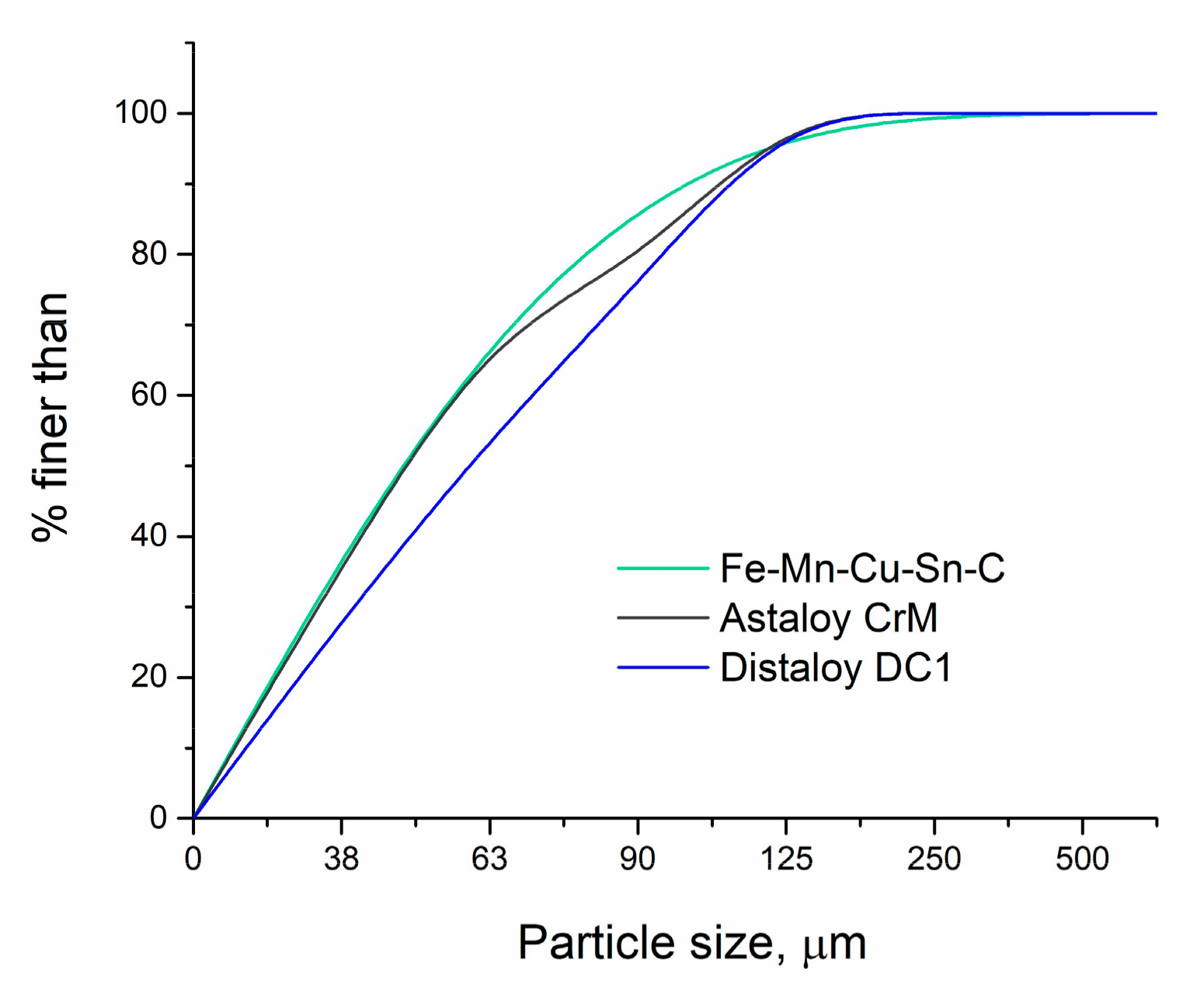



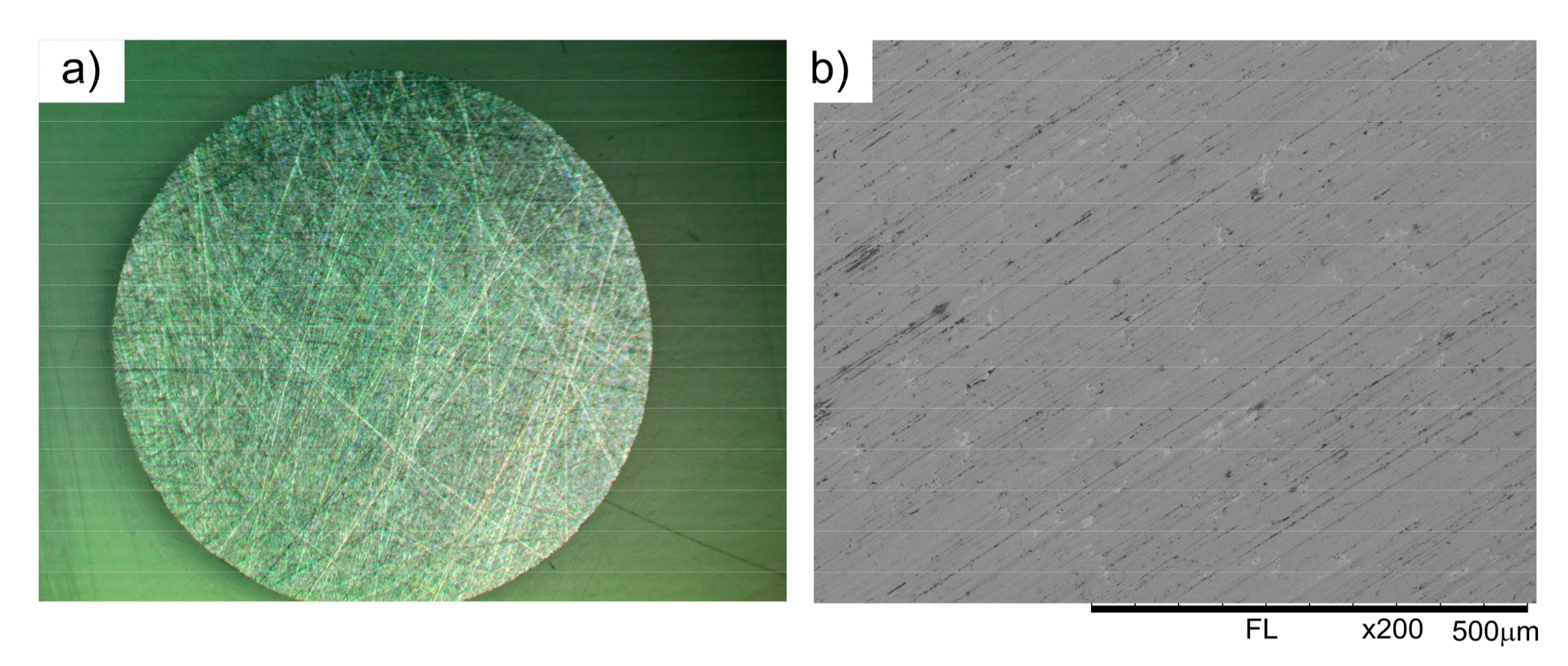
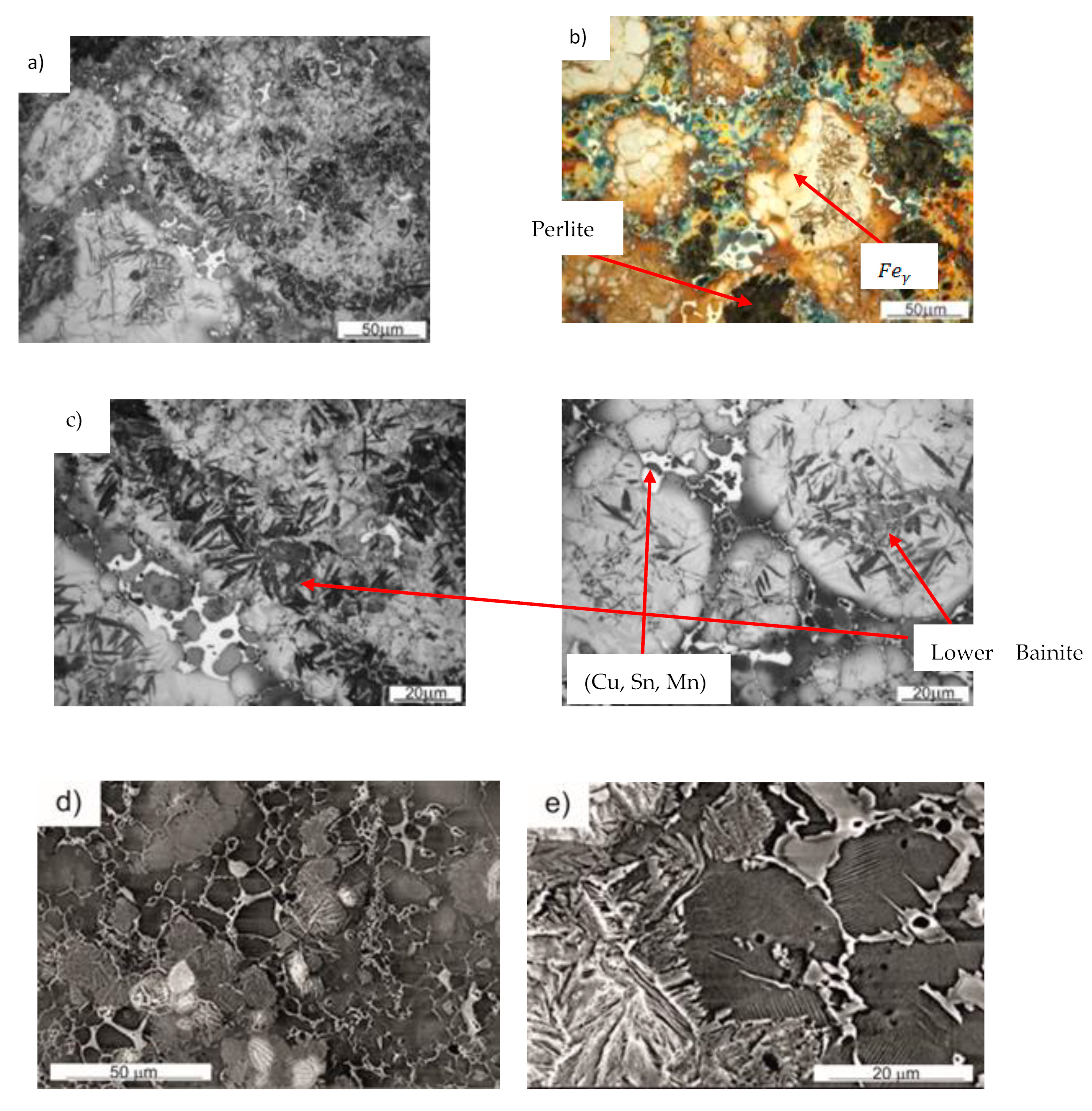
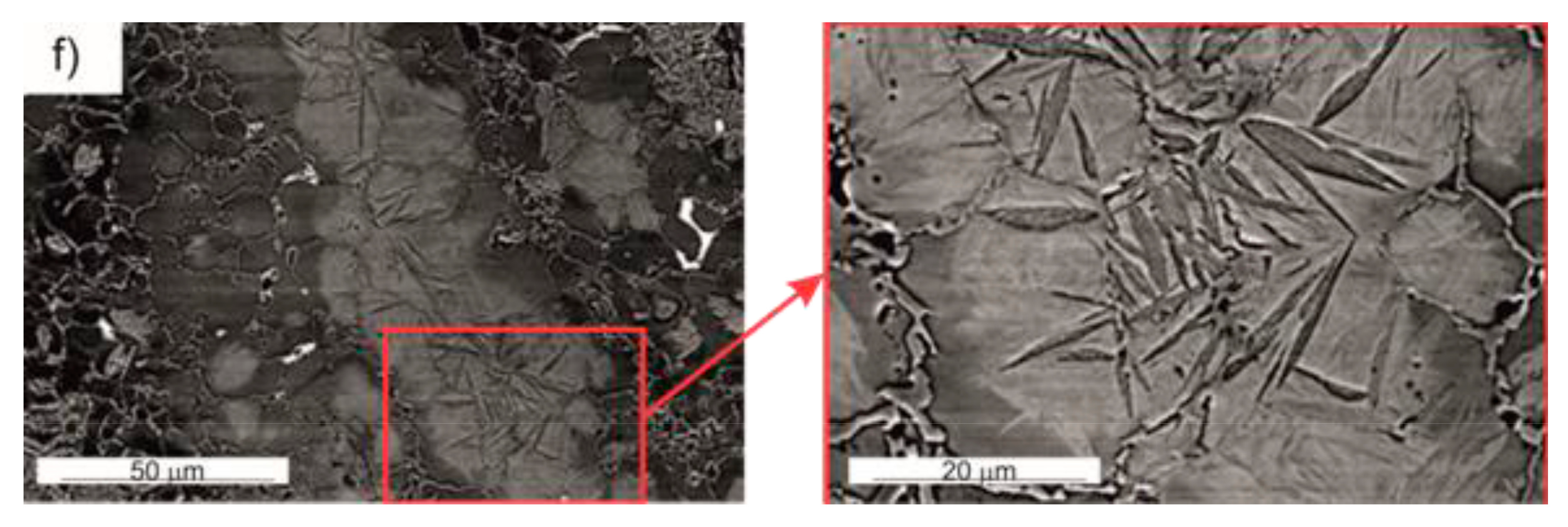
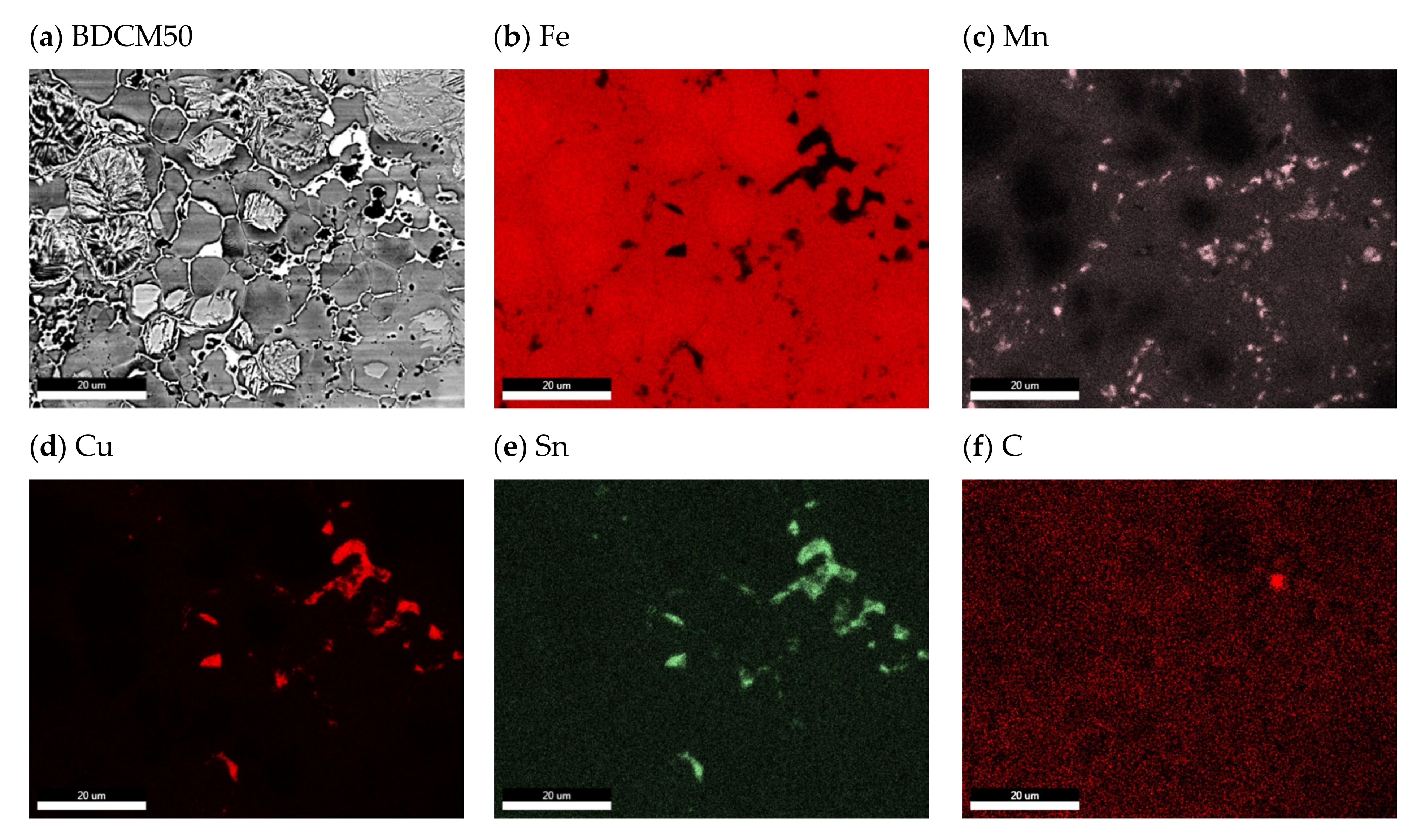

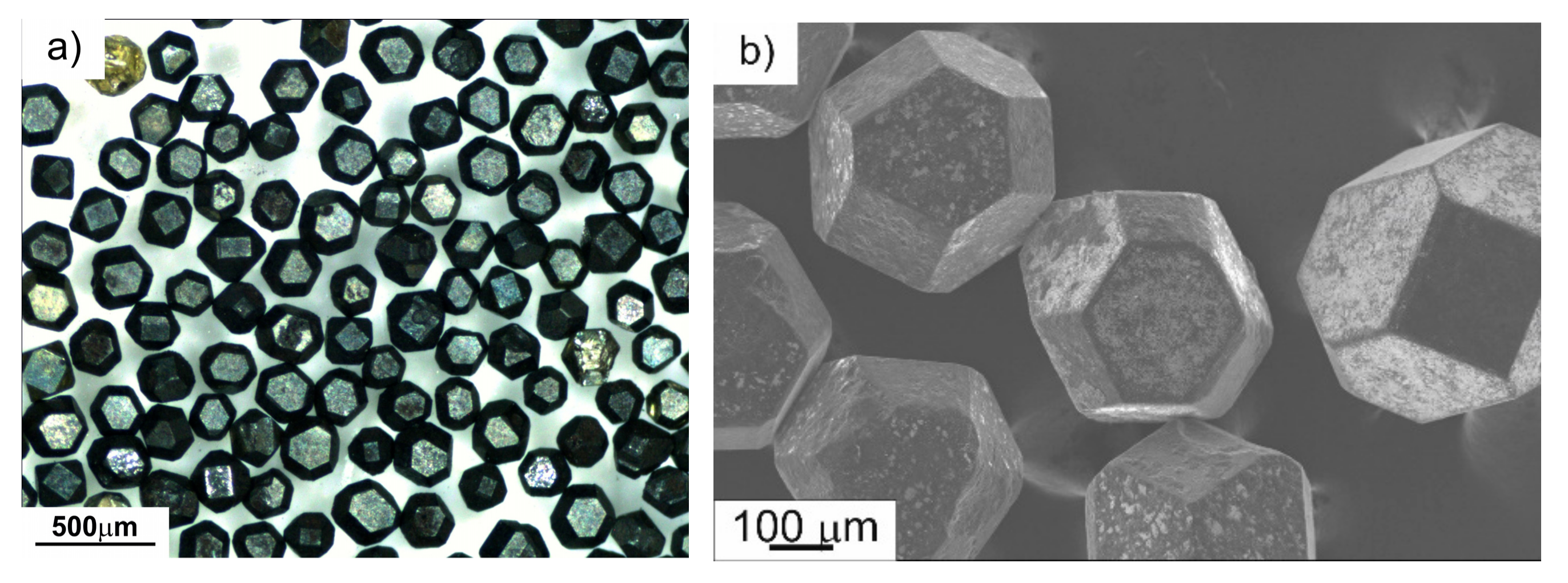
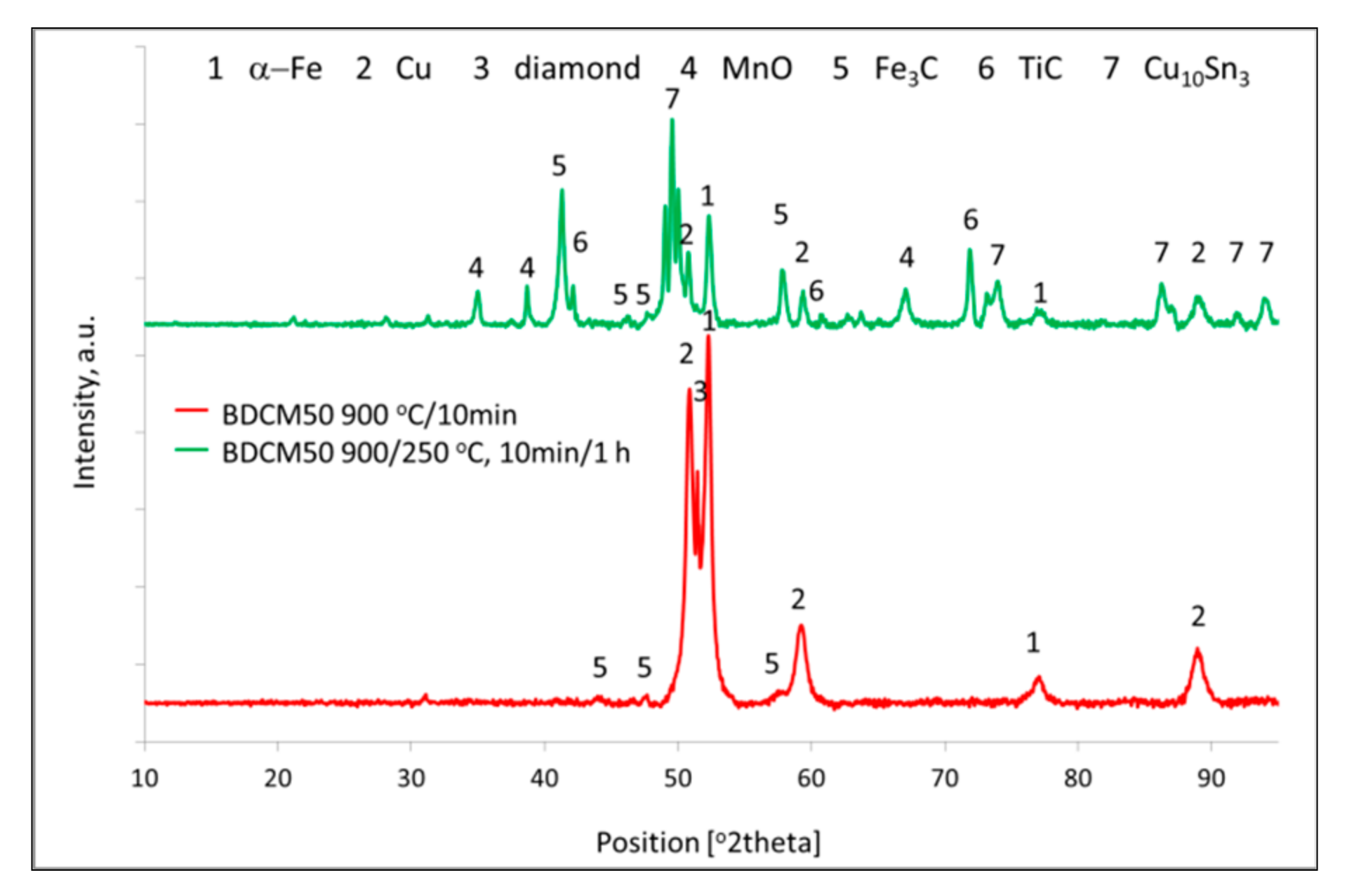
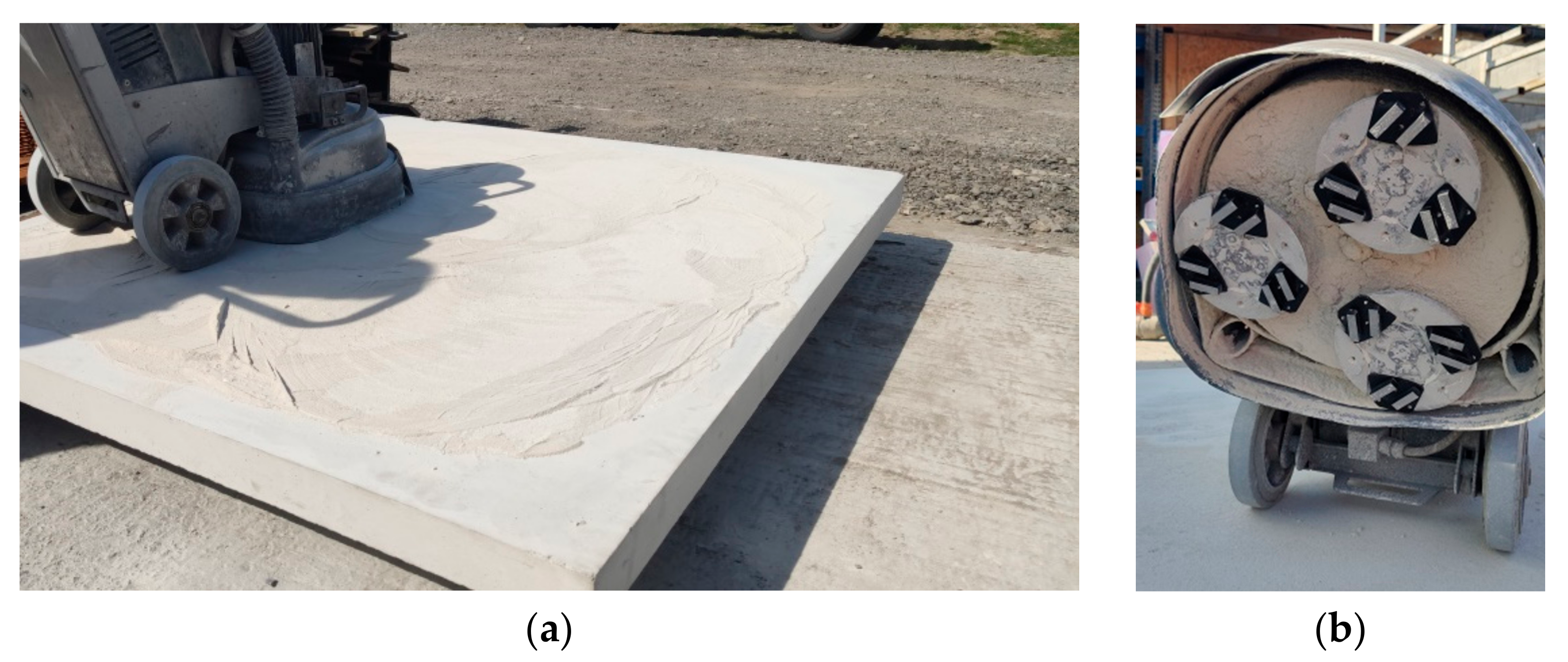
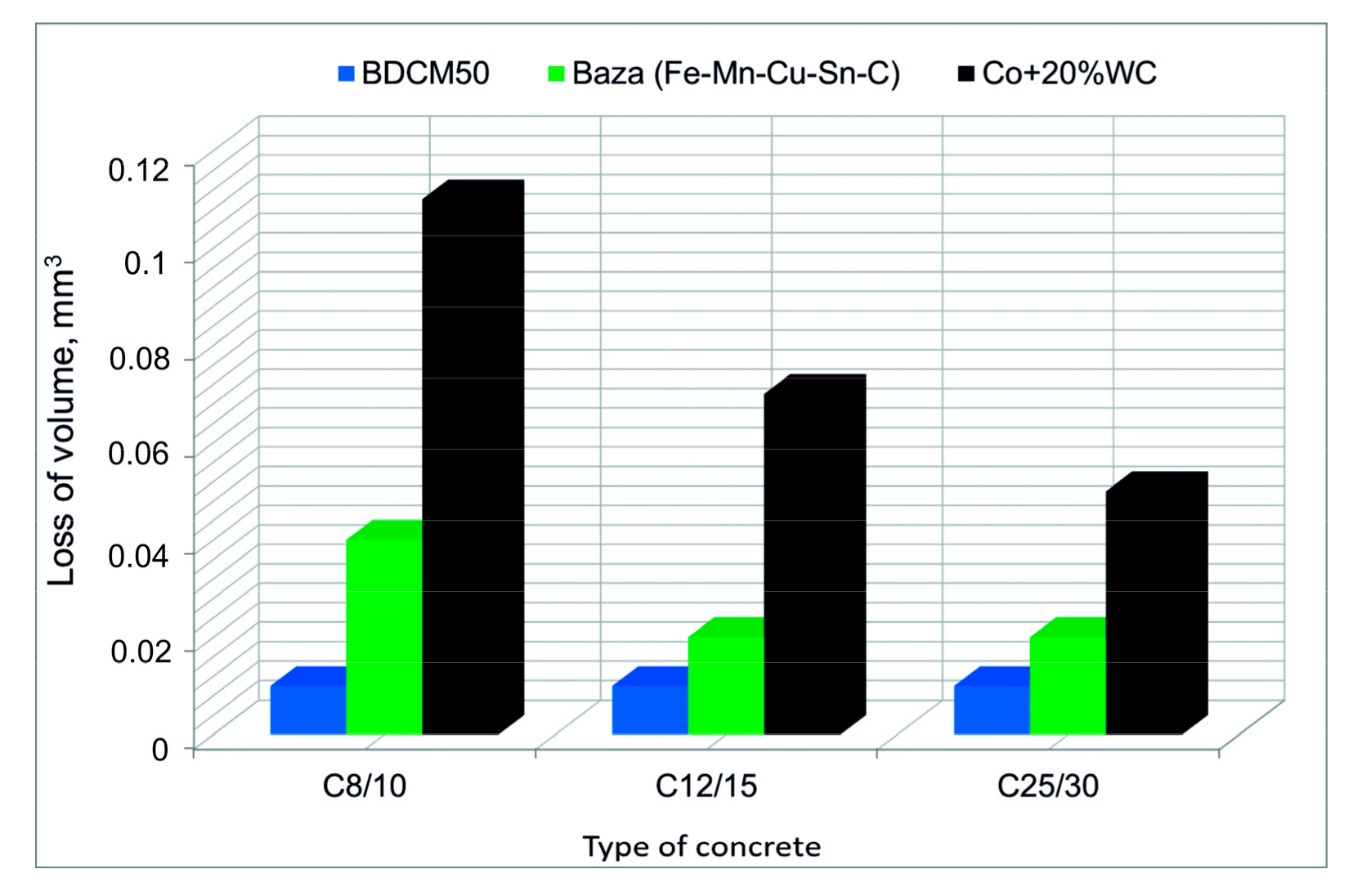
| Powder | Chemical Composition (wt.%) 1 | |||||||
|---|---|---|---|---|---|---|---|---|
| Fe | Mn | Cu | Sn | C | Cr | Mo | Ni | |
| Base (Fe-Mn-Cu-Sn-C) | bal. | 12 | 6.4 | 1.6 | 0.64 | |||
| Astaloy CrM | bal. | 0.006 | 2.94 | 0.52 | ||||
| Distaloy DC1 | bal. | 0.04 | 0.004 | 1.51 | 1.98 | |||
| Designation | Powder Composition (wt.%) | Chemical Composition (wt.%) | ||||||||
|---|---|---|---|---|---|---|---|---|---|---|
| DCM | Fe-Mn-Cu-Sn-C | Fe | Mn | Cu | Sn | C | Cr | Mo | Ni | |
| BDCM10 | 10 | 90 | 81.0 | 10.8 | 5.8 | 1.4 | 0.6 | 0.1 | 0.1 | 0.1 |
| BDCM30 | 30 | 70 | 84.3 | 8.4 | 4.5 | 1.1 | 0.6 | 0.4 | 0.3 | 0.3 |
| BDCM50 | 50 | 50 | 87.6 | 6.0 | 3.2 | 0.8 | 0.6 | 0.7 | 0.5 | 0.5 |
| Powder | Apparent Density (g/cm3) | Mean Particle Size 2, µm |
|---|---|---|
| Base (Fe-Mn-Cu-Sn-C) | 3.57 | 86 |
| Astaloy CrM | 2.81 | 91 |
| Distaloy DC1 | 3.05 | 98 |
| Material | Density (1) (g cm−3) | HV10 (1) | (1) (µm/20 m) | (1) (µm/20 m) | Three-Point Bending Test (1) | ||
|---|---|---|---|---|---|---|---|
| σTRS (MPa) | σ0.2 (MPa) | εpl (%) | |||||
| BDCM50 | 7.82 ± 0.01 | 379 ± 23 | 18.1 ± 3.9 | 95.9 ± 11.8 | 1239 ± 70 | 1045 ± 35 | 1.38 ± 0.4 |
| Base (Fe-Mn-Cu-Sn-C) | 7.75 ± 0.01 | 299 ± 7 | 24.6 ± 2.7 | 138.7 ± 1.2 | 1223 ± 103 | 924 ± 29 | 2.62 ± 0.8 |
| Co+20%WC | 9.25 ± 0.01 | 374 ± 17 | 48.8 ± 5.9 | 177.1 ± 9.2 | 1929 ± 162 | 1737 ± 79 | 1.84 ± 0.8 |
Disclaimer/Publisher’s Note: The statements, opinions and data contained in all publications are solely those of the individual author(s) and contributor(s) and not of MDPI and/or the editor(s). MDPI and/or the editor(s) disclaim responsibility for any injury to people or property resulting from any ideas, methods, instructions or products referred to in the content. |
© 2023 by the authors. Licensee MDPI, Basel, Switzerland. This article is an open access article distributed under the terms and conditions of the Creative Commons Attribution (CC BY) license (https://creativecommons.org/licenses/by/4.0/).
Share and Cite
Cygan-Bączek, E.; Cygan, S.; Wyżga, P.; Novák, P.; Lapčák, L.; Romański, A. Improvement in Abrasive Wear Resistance of Metal Matrix Composites Used for Diamond–Impregnated Tools by Heat Treatment. Materials 2023, 16, 6198. https://doi.org/10.3390/ma16186198
Cygan-Bączek E, Cygan S, Wyżga P, Novák P, Lapčák L, Romański A. Improvement in Abrasive Wear Resistance of Metal Matrix Composites Used for Diamond–Impregnated Tools by Heat Treatment. Materials. 2023; 16(18):6198. https://doi.org/10.3390/ma16186198
Chicago/Turabian StyleCygan-Bączek, Elżbieta, Sławomir Cygan, Piotr Wyżga, Pavel Novák, Ladislav Lapčák, and Andrzej Romański. 2023. "Improvement in Abrasive Wear Resistance of Metal Matrix Composites Used for Diamond–Impregnated Tools by Heat Treatment" Materials 16, no. 18: 6198. https://doi.org/10.3390/ma16186198





